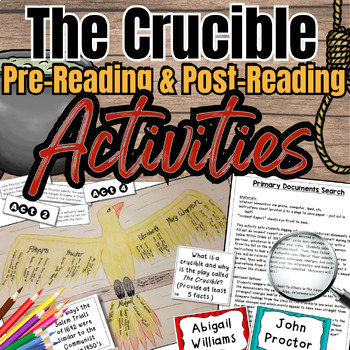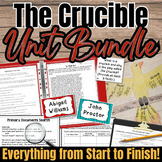The Crucible Engaging Activities - 12 Pre-Reading & Post-Reading Tasks
- Zip
Also included in
- Looking for some fresh ideas to engage, challenge, and immerse your students in the amazing play The Crucible by Arthur Miller? This bundle has everything you need from start to finish! ✨✨✨THE CRUCIBLE ACTIVITIES BUNDLE (Includes 12 Different Activities!)Pre-reading activities include:❶ A history viPrice $18.95Original Price $26.20Save $7.25
- American Literature Full Year or Semester Plus Writing & More BUNDLE lessons are designed for 90 minute blocks for a semester but can be divided for 45-50 minute yearlong classes. See the end of the list of resources for a pacing guide to use with the literature and sprinkle in the writing and oPrice $185.00Original Price $332.68Save $147.68
- Looking for thorough, engaging resources for American literature that you and your students will love? Want to make American literature relevant and exciting for today's learners? This bundle has you covered for this entire course! Everything you need is included, and you receive any future lessonsPrice $135.00Original Price $243.10Save $108.10
Description
Looking for some fun, unique, and engaging activities to supplement The Crucible? These activities are perfect for learning background information before reading the play and assessing students' understanding after studying the play.
Pre-reading activities include:
❶ A history video viewing guide that corresponds with Salem Witch Trials documentary from the History Channel with answer key.
❷ a handout where students determine which information is true, false, or simply opinionated about the history of the Salem Witch Trials with answer key.
❸ Research task cards with topics pertaining to the history of the trials, and students research their particular topic, collaborate with others, and present findings to the class. It is important that students are familiar with the history of the trials before reading The Crucible play. This is a short task - not a long research lesson.
Post-reading activities include:
❹ A character brainstorming game that acts as review for the play and scaffolding for an essay. This game requires students to move, think, collaborate, write, and evaluate.
➎ Instructions for how to write an expository essay, expository essay assignment, scaffolding tasks, and rubric
❻ Creative conflict map requiring students to think thoroughly and analytically. Examples included.
❼ Crucibles in Life competition - links today's crucibles to those in Puritan times. Suggested answers included.
❽ A list of 6 of differentiated project choices with detailed instructions for each choice.
❾ Primary historical documents exploration to complete an incident report where students go straight to the court documents of Salem. to look for charges, witnesses, and evidence. This is print and go ready with an instruction sheet for students and an incident report to complete.
❿ Hands-on plot activity - students cut the events apart and put them in the correct acts in order of occurrence as review.
❶❶ Visual literacy practice- students look at political cartoons from McCarthy era and determine their relevance to the Salem trials. An interactive discussion option is included.
❶ ❷Fact or Fiction task were students compare the play to real historical events and hypothesize why Miller made those changes.
►I have also included a character list with student selection questions to make assigning roles easier.
►Common Core Standards are aligned for each activity.
These activities help students understand the events of the play while having fun, being creative, and thinking critically/analytically. Several of these are hands-on and require students to "think outside the box." There are so many activities to choose from that you may not have time for them all, but you can select those activities that fit your students' needs and abilities.
You might also like . . .
• The Crucible Unit Bundle: Activities, Reading Guides, Quizzes, Test, & More
• The Crucible 1996 Movie Viewing Guide & Thinking Tasks - Digital & Print
• Salem Witch Trials Escape Room: The Case of Bridget Bishop
• Sinners in the Hands of an Angry God Plus More Activities by Jonathan Edwards
• Puritan Poetry - "Huswifery" and "Upon the Burning of Our House"
• Witch Hunts in the 21st Century: Read, Write, Think, Move, Talk Nonfiction Text
If you need an ENTIRE semester of American literature lessons and activities at your fingertips, visit American Literature Full Year/Semester for more stress-free planning!








